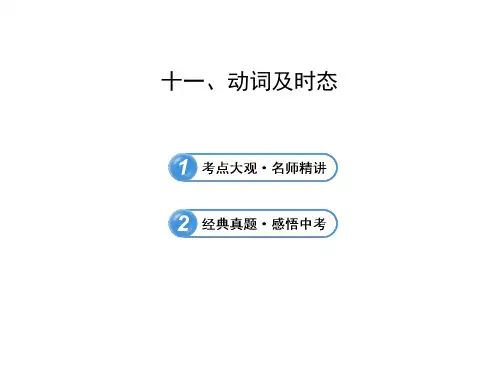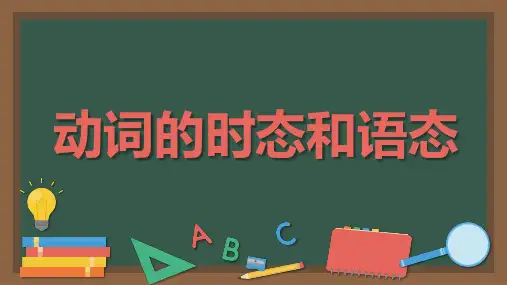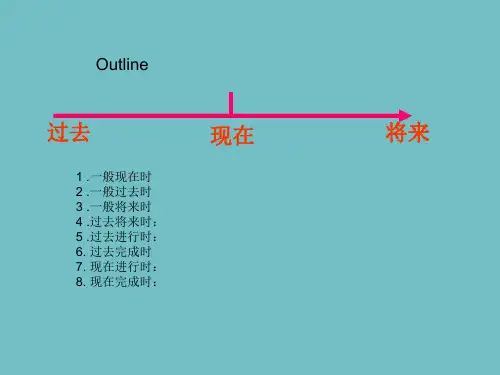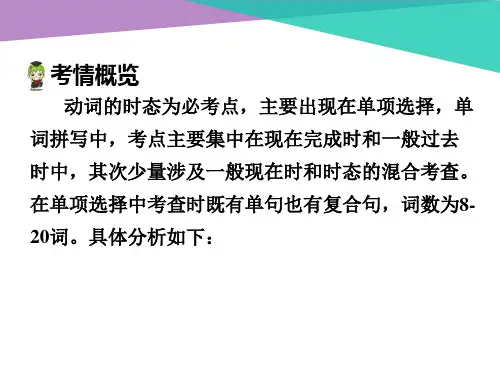- 1、下载文档前请自行甄别文档内容的完整性,平台不提供额外的编辑、内容补充、找答案等附加服务。
- 2、"仅部分预览"的文档,不可在线预览部分如存在完整性等问题,可反馈申请退款(可完整预览的文档不适用该条件!)。
- 3、如文档侵犯您的权益,请联系客服反馈,我们会尽快为您处理(人工客服工作时间:9:00-18:30)。
4. 在时间,条件状语从句中代替过去将来时. e.g. He would give her the book if he saw her.
(4) 过去进行时 1.表示过去某一时刻正在进行的动作.
e.g. He was doing shopping this time yesterday. We were having a discussion at that time. 2. 表示过去某一阶段正在进行的动作.
e.g. I have already sent him a card.
They have bought a new house. 常用的时间状语:already, just, yet 2. 表示从过去某一时间持续到说话时为止的动作或状 态, 常与 “ for+ 时间段 ” 或 “ since + 时间点 ” 的时间状语连用。
My brother has been in the army for a year. My brother joined the army one year ago.
但是: 不可持续动词的否定结构可以与” for + 时间段 ”
或since + 时间点” 连用。 e.g. I haven’t met my teacher of English for a year.
e.g. Do you see a plane in the sky? 注意:1) feel 可以用一般时和进行时表示说话时的感觉:
e.g. I am not feeling well today.
How are you feeling today?
I feel tired. 2) see, hear 有相应表示动作的动词 look at / listen to , 这些词可以用进行时
而用一般现在时表示状态或感觉,如 love, like, hate, want, need, wish, know(知道), understand(懂得), remember(记得), believe, guess(认为), mean(意味着), think(认为), feel(认为), fit(合适), find(认为), show(表明), have(有)
e.g. He was writing a composition last night.(作文不 一定完成) He wrote a composition last night.(作文肯定写完了)
(5) 现在完成时 I. 构成: have / has + 动词的过去分词 II. 用法:
1. 表示说话前某一个时刻发生的动作之结果对现在的 影响。
作: e.g. We are writing a paper these days.
一般现在时与现在进行时的区别 1.进行时强调动作正在进行,而现在时强调动作的经常和
反复,或特征,这类动作没有时间性的. 2.某些表示感官知觉的动词如: see, hear, smell, taste等
表示感觉,用一般时,不用进行时.
always often usually sometimes
seldom never from time to time now and then (偶尔) every day every …. once a week 2.表示状态:
e.g. He is busy at the moment. 3. 表示客观真理,谚语,格言.
e.g. The sun sets in the west.
4. 用与时间或条件状语从句中, 代替一般将来时: e.g. I will be happy if you all come. We will go when he comes.
(2) 现在进行时 1.表示说话时正在进行的动作.
e.g. He is walking towards the plane. 2. 表示目前一阶段正在进行(但说话时不一定在进行)的动
He is seeing his friend off at the airport.
I think they will come. We are all thinking hard.
The report shows the problem is serious. He is showing them around our school.
6. 7.
–__W_D_h_oa_et shthaes
hhaatp_p_e_fni_te_d__to(ftiht)emfieshw, eMlla?ry?
-- Mum, the cat ______ (eat) the fish. Just now the cat 8. _S_a_m__j_u(_jmu_mp_(epdl)ivoen)tionththhaesetesaambtleaenllatnodw_n_f_o_r_f(ievaet)yaiettaeurps.during the
I had breakfast a moment ago. (时间)
I have finished my homework. I finished my home at home. (地点) 2)现在完成时表示的持续状态强调持续到说话时为止, 与现在有联系, 而一般过去时表示的持续状态强调过去 某段时间的经历, 与现在没有联系。
e.g. I hope you will enjoy your meal.
I want to visit them tomorrow.
4. 当有些感觉动词词义转变,成为表示动作的动词时,可以 用进行时: e.g. Now I see the liquid in the glass has turned red.
时.
e.g. Edison invented the electric light. 2. 表示过去经常反复发生的动作.
e.g. Peter often played basketball when he was in
college.
3. 表示主语过去的状态或特征. e.g. It was rainy last week. He was a taxi driver years ago.
(4) 过去进行时 1.表示过去某一时刻正在进行的动作.
e.g. He was doing shopping this time yesterday. We were having a discussion at that time. 2. 表示过去某一阶段正在进行的动作. e.g. Peter was playing chess the whole afternoon
e.g. We have learned English for about three years.
He has been here since last term.
III. 现在完成时与一般过去时的区别: 1) 完成时强调过去发生的动作的结果和影响;而一般过 去时强调动作发生的时间,地点,方式等,与现在没有 联系。 e.g. I have just had breakfast.
比较: Do you see a map on the wall?
He is looking at a map on the wall.
I hear a strange noise from the car engine.
He is listeningБайду номын сангаасto the music. 3. 有些表示状态或心理感觉的动词一般不用现在进行时,
动词时态
初中阶段8种时态: 1.一般现在时 2.一般过去时 3.一般将来时 4.现在进行时 5.过去进行时 6.现在完成时 7.过去完成时 8.过去将来时
(1) 一般现在时: 1.表示经常反复发生的动作.
e.g. They often spend their holidays in the south. 常搭配的时间状语:
war. lived
9. It is ages since I last ____(see) you. You ___h(agvreowgr)otwanller. 10. He won’t tell us where hsea_w_____(get) the book.
got
(3) 一般过去时 1.表示过去某一具体时间发生过的动作.
e.g. The Greens have stayed in China for a year. The Greens stayed in China for a year during
the war.
I have learned computer for some time. I learned computer for some time while in middle school.
e.g. I reviewed my lessons last night. 注意: 1)有时句中虽然没有表示确定过去时间
的状语, 但根据上下文情景可以推断出是过去发生过的 动作,此时也应用一般过去时
e.g. I was sorry to learn of your illness.
I didn’t know he was your father. 2)描述已故之人的动作或状态用一般过去
We haven’t met each other since he left.
3) till / until 用法 可持续动词 + till / until : “某动作一直持续到…” not + 不可持续动词+ till / until: “直到…才…”
As we were leaving, some of our friends arrived. When we were playing in the playground , it began to rain.










